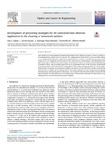Mostrar o rexistro simple do ítem
Development of processing strategies for 3D controlled laser ablation: Application to the cleaning of stonework surfaces
| dc.contributor.author | López, Ana | |
| dc.contributor.author | Lamas, Javier | |
| dc.contributor.author | Pozo Antonio, José Santiago | |
| dc.contributor.author | Rivas Brea, Teresa | |
| dc.contributor.author | Ramil, Alberto | |
| dc.date.accessioned | 2024-02-08T14:08:29Z | |
| dc.date.issued | 2020-03 | |
| dc.identifier.citation | López AJ, Lamas J, Pozo-Antonio JS, Rivas T, Ramil A. Development of processing strategies for 3D controlled laser ablation: Application to the cleaning of stonework surfaces. Optics and Lasers in Engineering 2020;126:105897. https://doi.org/10.1016/j.optlaseng.2019.105897. | es_ES |
| dc.identifier.issn | 1873-0302 | |
| dc.identifier.uri | http://hdl.handle.net/2183/35526 | |
| dc.description.abstract | [Abstract] Laser cleaning is an environmentally friendly method based on laser ablation processes to remove impurities or contaminants from a surface layer of a material. The configuration of a laser station in the case of flat surfaces is not complicated because laser irradiates from a fixed position. In contrast, controlled laser processing of 3D surfaces is not yet completely solved because the laser beam must be scanned along a three dimensional (3D) path. In this paper, a 3D laser processing strategy was developed to achieve an accurate and successful cleaning of freeform surfaces. Laser processing trajectories can be programmed directly on the 3D surface model instead of the 2D projection, which ensures both constant fluence and constant scanning speed all over the 3D surface during the laser processing. The strategy was applied to the removal of spray paint from a granite carved skirting board in order to validate the 3D cleaning system. The results, evaluated by means of hyperspectral imaging, stereomicroscopy and scanning electron microscopy, were compared with those of the surfaces treated with the same parameters but deactivating the 3D processing system. These analyses confirmed the improvement of the cleaning process when the 3D processing system is applied. | es_ES |
| dc.description.sponsorship | This work was supported by the Spanish Government Research Projects BIA2017-85897-R and BIA2014-54186-R. J. Santiago Pozo-Antonio was supported by a postdoctoral contract awarded by the University of Vigo within the framework of the 2011–2015 Galician Plan for Research, Innovation and Growth (Plan I2C) for 2014. | es_ES |
| dc.language.iso | eng | es_ES |
| dc.publisher | Elsevier | es_ES |
| dc.relation | info:eu-repo/grantAgreement/MINECO/Plan Estatal de Investigación Científica y Técnica y de Innovación 2013-2016/BIA2014-54186-R/OPTIMIZACION DE LA LIMPIEZA CON LASER DE PATINAS DESARROLLADAS SOBRE GRANITOS Y ROCAS AFINES. APLICACION A LA CONSERVACION DEL PATRIMONIO | es_ES |
| dc.relation | info:eu-repo/grantAgreement/AEI/Plan Estatal de Investigación Científica y Técnica y de Innovación 2013-2016/BIA2017-85897-R/OPTIMIZACION DE LOS PROCESOS DE ABLACION LASER PARA LA LIMPIEZA Y TEXTURIZADO DE SUPERFICIES EN 3D DE ROCAS ORNAMENTALES | es_ES |
| dc.relation.uri | https://doi.org/10.1016/j.optlaseng.2019.105897 | es_ES |
| dc.subject | 3D laser processing | es_ES |
| dc.subject | Laser ablation | es_ES |
| dc.subject | Paint removal | es_ES |
| dc.subject | Carved stone | es_ES |
| dc.subject | Granite | es_ES |
| dc.title | Development of processing strategies for 3D controlled laser ablation: Application to the cleaning of stonework surfaces | es_ES |
| dc.type | info:eu-repo/semantics/article | es_ES |
| dc.rights.access | info:eu-repo/semantics/embargoedAccess | es_ES |
| dc.date.embargoEndDate | 9999-99-99 | es_ES |
| dc.date.embargoLift | 10007-06-07 | |
| UDC.journalTitle | Optics and Lasers in Engineering | es_ES |
| UDC.volume | 126 | es_ES |
| dc.identifier.doi | https://doi.org/10.1016/j.optlaseng.2019.105897 |
Ficheiros no ítem
Este ítem aparece na(s) seguinte(s) colección(s)
-
CIT-LAIL - Artigos [31]






